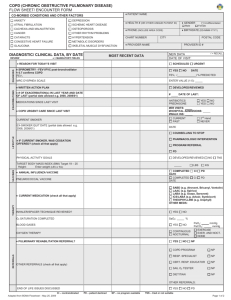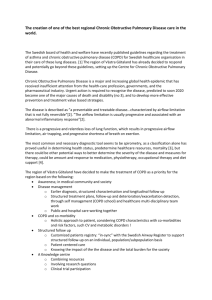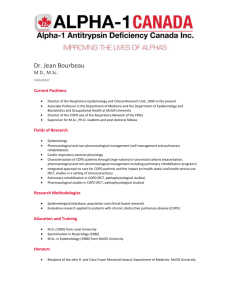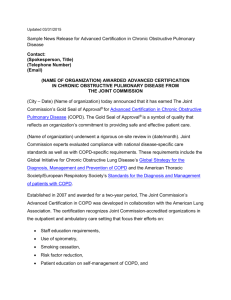Exercise performance and physical activity monitoring
advertisement
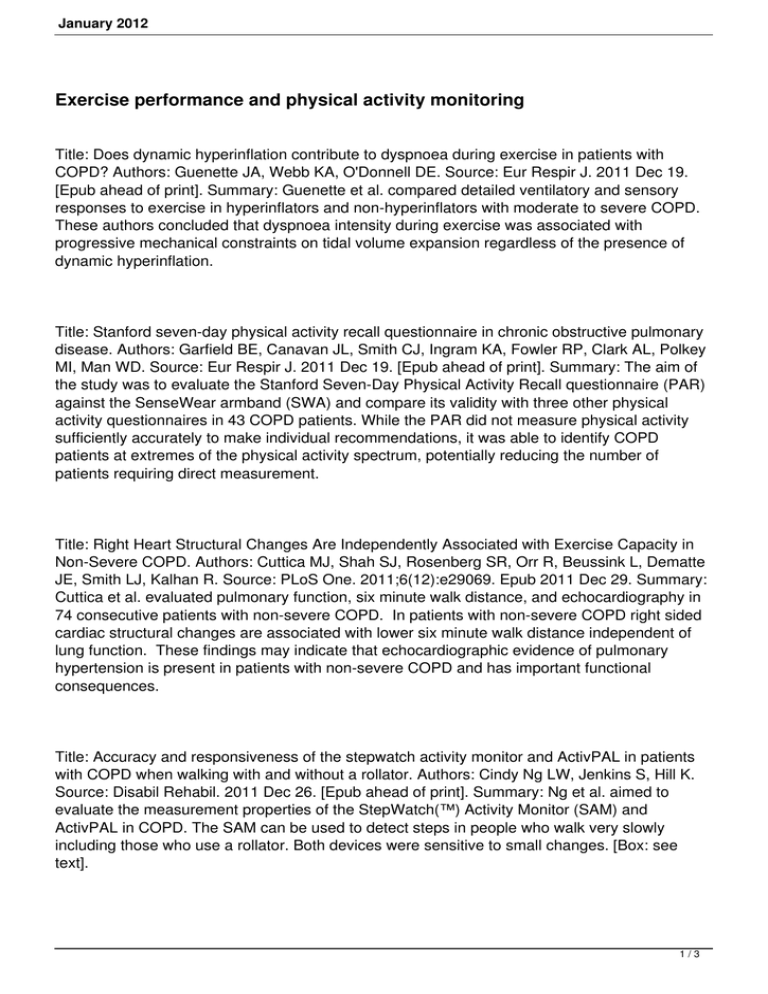
January 2012 Exercise performance and physical activity monitoring Title: Does dynamic hyperinflation contribute to dyspnoea during exercise in patients with COPD? Authors: Guenette JA, Webb KA, O'Donnell DE. Source: Eur Respir J. 2011 Dec 19. [Epub ahead of print]. Summary: Guenette et al. compared detailed ventilatory and sensory responses to exercise in hyperinflators and non-hyperinflators with moderate to severe COPD. These authors concluded that dyspnoea intensity during exercise was associated with progressive mechanical constraints on tidal volume expansion regardless of the presence of dynamic hyperinflation. Title: Stanford seven-day physical activity recall questionnaire in chronic obstructive pulmonary disease. Authors: Garfield BE, Canavan JL, Smith CJ, Ingram KA, Fowler RP, Clark AL, Polkey MI, Man WD. Source: Eur Respir J. 2011 Dec 19. [Epub ahead of print]. Summary: The aim of the study was to evaluate the Stanford Seven-Day Physical Activity Recall questionnaire (PAR) against the SenseWear armband (SWA) and compare its validity with three other physical activity questionnaires in 43 COPD patients. While the PAR did not measure physical activity sufficiently accurately to make individual recommendations, it was able to identify COPD patients at extremes of the physical activity spectrum, potentially reducing the number of patients requiring direct measurement. Title: Right Heart Structural Changes Are Independently Associated with Exercise Capacity in Non-Severe COPD. Authors: Cuttica MJ, Shah SJ, Rosenberg SR, Orr R, Beussink L, Dematte JE, Smith LJ, Kalhan R. Source: PLoS One. 2011;6(12):e29069. Epub 2011 Dec 29. Summary: Cuttica et al. evaluated pulmonary function, six minute walk distance, and echocardiography in 74 consecutive patients with non-severe COPD. In patients with non-severe COPD right sided cardiac structural changes are associated with lower six minute walk distance independent of lung function. These findings may indicate that echocardiographic evidence of pulmonary hypertension is present in patients with non-severe COPD and has important functional consequences. Title: Accuracy and responsiveness of the stepwatch activity monitor and ActivPAL in patients with COPD when walking with and without a rollator. Authors: Cindy Ng LW, Jenkins S, Hill K. Source: Disabil Rehabil. 2011 Dec 26. [Epub ahead of print]. Summary: Ng et al. aimed to evaluate the measurement properties of the StepWatch(™) Activity Monitor (SAM) and ActivPAL in COPD. The SAM can be used to detect steps in people who walk very slowly including those who use a rollator. Both devices were sensitive to small changes. [Box: see text]. 1/3 January 2012 Title: Impact of Exercise Capacity on Dyspnea and Health-Related Quality of Life in Patients with Chronic Obstructive Pulmonary Disease. Authors: Jacobsen R, Frølich A, Godtfredsen NS. Source: J Cardiopulm Rehabil Prev. 2011 Dec 21. [Epub ahead of print]. Summary: The aim of this study was to assess the impact of the amount of exercise training during pulmonary rehabilitation program for improvements in dyspnea and health-related quality of life in patients with COPD. Quality of life in patients with COPD is predicted by dyspnea. Thus, to further investigate the influence of exercise training on quality of life in patients with CODP, simultaneous assessment of dyspnea should be considered. Behavior Title: Behavioral and characterological self-blame in chronic obstructive pulmonary disease. Authors: Plaufcan MR, Wamboldt FS, Holm KE. Source: J Psychosom Res. 2012 Jan;72(1):78-83. Epub 2011 Dec 7. The purpose of this study was to assess behavioral and characterological self-blame, identify demographic and relational correlates of self-blame, and determine the association of self-blame with psychological and clinical outcomes of COPD. Plaufcan et al. conclude that individuals with COPD tend to blame themselves for smoking and other behaviors that may have led to their COPD. Title: Chronic obstructive pulmonary disease is associated with altered neuropsychological performance in young adults. Authors: De Carolis A, Giubilei F, Caselli G, Casolla B, Cavallari M, Vanacore N, Leonori R, Scrocchia I, Fersini A, Quercia A, Orzi F. Source: Dement Geriatr Cogn Dis Extra. 2011 Jan;1(1):402-8. Epub 2011 Nov 16. Summary: In this case-control, cross-sectional study, De Carolis et al. sought to test the hypothesis that hypoxia facilitates cognitive decline. The COPD patients had a slightly, but significantly worse performance than controls in a number of neuropsychological tests. The findings are consistent with the working hypothesis that chronic hypoxia facilitates cognitive decline. Co-morbidities Title: The association of low bone mineral density with systemic inflammation in clinically stable COPD. Authors: Liang B, Feng Y. Source: Endocrine. 2011 Dec 24. [Epub ahead of print]. Summary: The aim of the present study was to explore the association of bone mineral density with systemic inflammation in patients with clinically stable COPD. It can be concluded that systemic inflammation is a significantly independent predictor of low bone mineral density in patients with clinically stable COPD. Title: Is chronic obstructive pulmonary disease associated with increased arterial stiffness? Authors: Janner JH, McAllister DA, Godtfredsen NS, Prescott E, Vestbo J. Source: Respir Med. 2/3 January 2012 2011 Dec 1. [Epub ahead of print]. Summary: Janner et al. hypothesized that airflow limitation is associated with increasing arterial stiffness and that having COPD increases a non-invasive measure of arterial stiffness - the aortic augmentation index (AIx) - independently of other CVD risk factors. AIx and COPD are only weakly associated. In the general population, this finding argues against increased arterial stiffness, as measured by AIx, being a complication of COPD. Exercise training and pulmonary rehabilitation Title: Have we underestimated the efficacy of pulmonary rehabilitation in improving mood? Authors: Harrison SL, Greening NJ, Williams JE, Morgan MD, Steiner MC, Singh SJ. Source: Respir Med. 2011 Dec 22. [Epub ahead of print]. Summary: The study aimed to explore the effectiveness of PR in reducing symptoms of anxiety and depression across a spectrum of severities. Pulmonary rehabilitation is effective in reducing symptoms of anxiety and depression. Title: Does exercise training change physical activity in people with COPD? A systematic review and meta-analysis. Authors: Ng LW, Mackney J, Jenkins S, Hill K. Source: Chron Respir Dis. 2011 Dec 22. [Epub ahead of print]. Summary: A systematic review and meta-analysis was conducted to examine the effect of exercise training on daily physical activity in people with COPD. Taken together, the randomized trials and single-group studies demonstrate that exercise training may confer a significant but small increase in physical activity. Title: A Simple Method for Home Exercise Training in Patients With Chronic Obstructive Pulmonary Disease: ONE-YEAR STUDY. Authors: Pomidori L, Contoli M, Mandolesi G, Cogo A. Source: J Cardiopulm Rehabil Prev. 2012 Jan;32(1):53-7. Summary: Pomidori et al. compared 2 methods of home long-term exercise training, based on walking in 47 patients with COPD. The use of a metronome to maintain the rate of walking during home ExT seems to be beneficial, allowing patients to achieve and sustain the optimal exercise intensity, and resulting in greater improvement compared to simply using a fixed time interval exercise. Skeletal muscle function Title: The effect of higher ATP cost of contraction on the metabolic response to graded exercise in patients with chronic obstructive pulmonary disease. Authors: Layec G, Haseler LJ, Richardson RS. Source: 2011 Dec 15. [Epub ahead of print]. Summary: (31)P-magnetic resonance spectroscopy ((31)P-MRS) was used to examine muscle energetic and pH in response to graded exercise. These results reveal that when energy demand is normalized to WRmax, as a consequence of higher ATP cost of contraction, patients with COPD display the same metabolic pattern as healthy subjects, suggesting that skeletal muscle energy production is well preserved in these patients. 3/3


